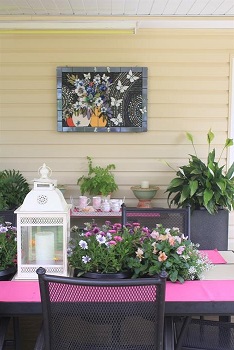 Pot plants can grow very quickly in the warmer conditions, and if you are not careful, they can run out of nutrients, or become pot bound and start to deteriorate.
Pot plants can grow very quickly in the warmer conditions, and if you are not careful, they can run out of nutrients, or become pot bound and start to deteriorate.
If your plants fit into one of the following groups, they may need annual repotting if growing in a greenhouse, sunroom, or warm part of a garden:
- If it is in a small pot and growing fast
- Indoor plants that have been in the same pot for more than two years
- The roots can be seen bulging out the base of the pot
Some plants will generally grow, and may flower better, if repotted each year. Examples include orchids, many types of bulbs, and most hanging baskets. Time for repotting varies though. Cymbidium orchids, in a mild temperate climate, are usually repotted around mid autumn, but some types of bulbs are more likely to rot if repotted in autumn, and may be better repotted late winter or spring.
Bonsai are frequently repotted each year although this may depend on the plant species and the growing conditions.
Not all plants like to be potted up. Many natives for example do not like root disturbance. In these cases, you can still feed, mulch, add wetting agents and water storing crystals, and prune back tops to reinvigorate them. This extra attention helps the plant overcome the pressure placed on the roots.
Plants that can be vulnerable to becoming pot bound include: Dieffenbachia, Chinese evergreens, Flamingo flower, Dwarf umbrella tree, African violets, Azaleas, Camellias, Citrus, Climbers, Cordylines, Heliconias, Palms, Philodendrons, and many more
Signs of a Pot Bound Plant
- Yellowish or pale leaves
- Extensive root growth coming through drainage holes
- Leaf drop
- They dry out/wilt regularly
- Stunted growth or lack of vigour
- Pots beginning to burst, particularly plastic ones, from root growth
- Extensive root growth at the top of the pot (hard to see any media)
- Flowers have ceased and plant looks ‘warn out’
How to Pot Up a Plant Step by Step:
- Obtain any necessary materials such as new pots, potting mix, and clean, sharp tools such as knives or secateurs. Choose a pot one or two sizes up from the existing pot, unless you are going to divide the plant into sections, in which case use pots similar in size to the existing pot. Choosing a much larger pot may result in a plant that looks out of proportion to the pot, or encourage the plant to grow too quickly resulting in a plant that while looking lush is soft, and hence easily damaged by adverse conditions, or is more susceptible to pests and diseases. Price may be an indication that it is of good quality, but not always.
- Water the plants to be potted up well, ideally the day before potting up (this helps reduce damage from water loss during potting up), and an hour or two before potting up. If the media is moist it will be easier to remove the plant from the pot.
- Prepare the pot to be used by placing some new potting mix in the base of the pot (sufficient so that when the plant is placed on top of the mix the top of the root ball is at the desired level). Fertiliser can be added to the potting mix prior to use. A slow release complete fertiliser such as Osmocote or Nutricote is commonly used.
- Remove the plant from its existing container. If it is very pot bound then you may need to break (for ceramic) or cut away (for plastic) the existing container.
- If the plant is not pot bound then simply place it in position in the new pot. If it is lightly pot bound you might be able to gently tease out the roots with your hands. For very pot bound plants you may need to remove some of the root mass with a sharp knife or secateurs and tease out the rest. The aim is to remove or tease out any tight masses of roots that are curling back into or tightly around the rootball.
- Once the plant is in position in the pot you may need to add or remove some of the new potting mix until you get the plant at the desired height. Then add in more potting mix around the sides of the root ball, lightly firming it down, until you have reached just above the level of the existing root ball. Gently tap the pot on something solid (if it is light enough to pick up), or give it a quick shake to settle the potting mix down. Add extra potting mix if necessary to readjust the height.
- Water well to settle the potting mix in.
Read more about selecting suitable plants in our What to Plant Where? ebook.